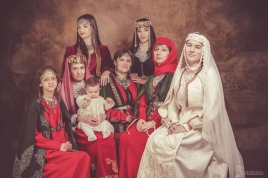Armenian dress
Friday, December 3, 2021
The dress of the Armenians (taraz), also known as Armenian traditional clothing, reflects a rich cultural tradition. Wool and fur were utilized by the Armenians along with the cotton that was grown in the fertile valleys. During the Urartian period, silk imported from China was used by royalty. Later, the Armenians cultivated silkworms and produced their own silk.
The collection of Armenian women’s costumes begins during the Urartu time period, wherein dresses were designed with creamy white silk, embroidered with gold thread. The costume was a replica of a medallion unearthed by archaeologists at Toprak Kale near Lake Van, which some 3,000 years ago was the site of the capital of the Kingdom of Urartu.
The Armenian national costume, having existed through long periods of historical development, was one of the signals of self-preservation for the Armenian culture. Being in an area at the crossroads of diverse eastern styles, Armenian dress is significant in not only borrowing but, also often playing an influential role on neighboring nations.
The costume can be divided into two main regions: Western Armenians and Eastern Armenians. Which in turn are divided into separate subregions.
The costume of the Armenians of Western Armenia is mainly divided into two regions:
1. Areas of the Eastern Provinces: Taron (including Sasun), Bardzr Hayk, Vaspurakan, and Baghesh.
2. The regions of Sebastia, Kayseri, Cilicia in the western states, and Kharberd-Tigranakert in the south.
The first group kept closer to the traditions of the Armenian costume while in the second group, the influence of some Anatolian cultures are seen.
Eastern Armenian costume can be divided into three regions:
1. Syunik-Artsakh, Zangezur, and Ayrarat.
2. Goghtan (Agulis, Ordubad)
3. Gandzak, Gugark, Shirak, Javakhk.
Colors
The Armenian costume is dominated by the colors of the four elements: earth, water, air, and fire. According, to the 14th century Armenian philosopher Grigor Tatatsi, the Armenian costume is made to express the ancestral soil, the whiteness of the water, the red of the air, and the yellow of the fire. Apricot symbolizes prudence and common sense, red symbolizes courage and martyrdom, blue symbolizes heavenly justice, white symbolizes purity. Some of the techniques used in making these costumes have survived to this day and are actively used in the applied arts, however, there are techniques that have been lost. Each province of Armenia stands out with its costume. The famous centers of Armenian embroidery - Van-Vaspurakan, Karin, Shirak, Syunik-Artsakh, Cilicia - stand out with their rhythmic and stylistic description of ornaments, color combinations and composition.
Ancient period: 900-600 BCE
The Urartians who were the predecessors to the Armenians wore a dress similar to that of Assyrians which consisted of short-sleeved tunics worn bare or with a shawl surrounding it. The Urartians decorated themselves with metal ornaments such as necklaces, bracelets, earrings, and pins. These metal ornaments were engraved with lion heads while necklaces of stone beads and long metal pins were draped across the body. Metal belts were an important part of the Urartian costume as well. The making of metal belts was considered an art form with magical scenes and animals being engraved into the belt in order to protect the wearer.
Classical period: 600 BCE-600 CE
The traditional dress of Armenians underwent a significant shift following the emergence of the Kingdom of Armenia as a distinct political entity. Armenian men wore fitted trousers and a distinct hat known as the Phrygian cap. This later evolved into the balshik which is a flexible accessory that is worn by shepherds and religious leaders alike.
Medieval period: 600-1600 BCE
Based on the works of Armenian manuscripts as well as images found on churches, coins, and khachkars, we can see that the Armenian elite wore clothing similar to that of Byzantine and Arab royalty, such as Turbans. Armenians held onto their unique traditions while also adopting from neighboring societies such as head coverings becoming commonplace for Armenian women.
19th century
In her 1836 novel titled The City of The Sultan; and Domestic Manners of the Turks, Julia Pardoe described the Armenian merchants she observed immediately upon disembarking.
As I looked on the fine countenances, the noble figures, and the animated expression of the party, how did I deprecate their shaven heads, and the use of the frightful calpac, which I cannot more appropriately describe than by comparing it to the iron pots used in English kitchens, inverted! The graceful pelisse, however, almost makes amends for the monstrous head-gear, as its costly garniture of sable or marten-skin falls back, and reveals the robe of rich silk, and the cachemire shawl folded about the waist.
Pardoe also mentions they wore bejeweled rings and carried in their hands "pipes of almost countless cost.”
Nowadays
Armenian traditional clothing started to fall out of use in the 1920s and was almost completely replaced by modern clothing by the 1960s. Today, Armenian traditional clothing is mostly used for dance performances where girls put on an arkhalig and long dress to simulate taraz while boys wear dark colored loose pants and a fitted jacket. In some areas of Armenia and Karabakh, elderly women still wear a short headscarf. Photo studios in Armenia allow for new generations to take pictures in traditional clothing and some women in recent times have begun to wear taraz again.
An annual festival celebrating Armenian traditional dress known as Taraz Fest is hosted every year in Yerevan and Stepanakert by the Teryan cultural center and consists of showcases of the cultural dress.





